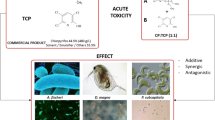Abstract
Chronic effect and no effect concentrations (28 day) and acute toxicity (48 hr, LC50 and EC50) values were determined forDaphnia magna with some chlorinated benzenes, chlorinated ethanes, and tetrachloroethylene. Acute and chronic toxicity generally increased with the degree of chlorine substitution with these chemicals. The 48 hr LC50 values for hexachloroethane, pentachloroethane, 1,1,2,2-tetrachloroethane, 1,1,2-trichloroethane, 1,2-dichloroethane, 1,2,4-trichlorobenzene, 1,3-dichlorobenzene, and tetrachloroethylene were 2.9, 7.3, 62, 190, 270, 2.1, 7.4, and 18 mg/L, respectively. The lowest observable effect concentrations (LOEC) based on either reproductive impairment or growth for 1,1,2,2-tetrachloroethane, 1,1,2-trichloroethane, 1,2-dichloroethane, 1,2,4-trichlorobenzene, 1,3-dichlorobenzene, and tetrachloroethylene were 14, 26, 20, 0.69, 1.5, and 1.1 mg/L, respectively. Length of animals at the end of chronic exposure was at least as sensitive a measure of toxic effect as reproduction with every chemical tested except 1,2-dichloroethane. The acute-chronic ratio ranged from 3 to 16 with these chemicals.
Similar content being viewed by others
References
Adema, D. M. M.:Daphnia magna as a test animal in acute and chronic toxicity tests. Hydrobiol.59, 125 (1978).
APHA (American Public Health Association), American Water Works Association, Water Pollution Control Federation: Standard methods for the examination of water and waste-water. 13 ed. Washington, DC: American Public Health Association (1971).
ASTM (American Society for Testing and Materials): Standard practice for conducting acute toxicity tests with fishes, macroinvertebrates, and amphibians. ASTM Standard E 729-80, 1. Philadelphia, PA: American Society for Testing and Materials (1980).
Barrows, M. E., S. R. Petrocelli, K. J. Macek, and J. J. Carroll: Bioconcentration and elimination of selected water pollutants by bluegill sunfish (Lepomis macrochirus), In R. Haque (ed.): Dynamics, exposure, and hazard assessment of toxic chemicals. Ann Arbor, MI: Ann Arbor Science Publishers (1980).
Biesinger, K. E., and G. M. Christensen: Effects of various metals on survival, growth, reproduction, and metabolism ofDaphnia magna. J. Fish. Res. Board Can.39, 1691 (1972).
Chapman, P. M., G. P. Romberg, and G. A. Vigers: Design of monitoring studies for priority pollutants. J. Water Pollut. Control Fed.54, (3 part 1) (1982).
Comotto, R.: ASTM (American Society for Testing and Materials) proposed standard practice for conducting renewal life cycle toxicity tests with the daphnidDaphnia magna. Draft No. 4, Philadelphia, PA: American Society for Testing and Materials (1978).
Crosby, D. G., R. K. Tucker, and N. Aharonson: The detection of acute toxicity withDaphnia magna. Fd. Cosmet. Toxicol.4, 503 (1966).
Fitzmayer, K. M., J. G. Geiger, and M. J. Van Den Avyle: Effects of chronic exposure to simazine on the cladoceran,Daphnia pulex. Arch. Environ. Contam. Toxicol.11, 603 (1982).
Geiger, J. G., A. L. Buikema, Jr., and J. Cairns, Jr.: A tentative seven-day test for predicting effects of stress on populations ofDaphnia pulex, In J. G. Eaton, P. R. Parrish, and A. C. Hendricks (eds.): Aquatic toxicology, ASTM STP 707, p. 13. Philadelphia, PA: American Society for Testing and Materials (1980).
Kirk, R. E., and D. Othmer (eds.): Encyclopedia of chemical technology. 2 ed. New York: John Wiley and Sons (1963).
LeBlanc, G. A.: Utilization of bacterial colony counters to count early instar water fleas (Daphnia magna). Bull. Environ. Contam. Toxicol.23, 837 (1979).
—: Acute toxicity of priority pollutants to water flea (Daphnia magna). Bull. Environ. Contam. Toxicol.24, 684 (1980).
Stephan, C. E.: Methods for calculating an LC50, In F. L. Mayer and J. L. Hamelink (eds.): Aquatic toxicology and hazard evaluation, STP 634, p. 65. Philadelphia, PA: American Society for Testing and Materials (1977).
U.S. Environmental Protection Agency: Ambient water quality criteria for chlorinated benzenes. EPA-440/5-80-028. National Technical Information Service, Springfield, VA (1980a).
—: Ambient water quality criteria for chlorinated ethanes. EPA-440/5-80-029. National Technical Information Service, Springfield, VA (1980b).
—: Ambient water quality criteria for tetrachloroethylene. EPA-440/5-80-073. National Technical Information Service, Springfield, VA (1980c).
Winner, R. W.: A comparison of body length, brood size, and longevity as indices of chronic copper and zinc stresses inDaphnia magna. Environ. Pollut. Ser. A.26, 33 (1981).
Author information
Authors and Affiliations
Rights and permissions
About this article
Cite this article
Richter, J.E., Peterson, S.F. & Kleiner, C.F. Acute and chronic toxicity of some chlorinated benzenes, chlorinated ethanes, and tetrachloroethylene toDaphnia magna . Arch. Environ. Contam. Toxicol. 12, 679–684 (1983). https://doi.org/10.1007/BF01060751
Received:
Revised:
Issue Date:
DOI: https://doi.org/10.1007/BF01060751




